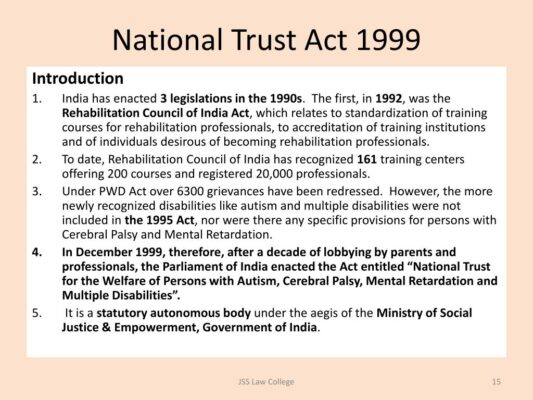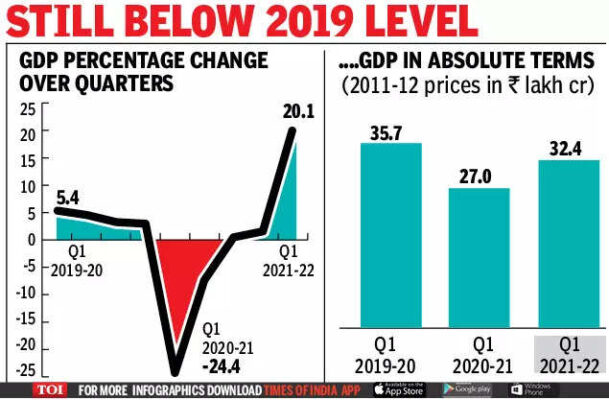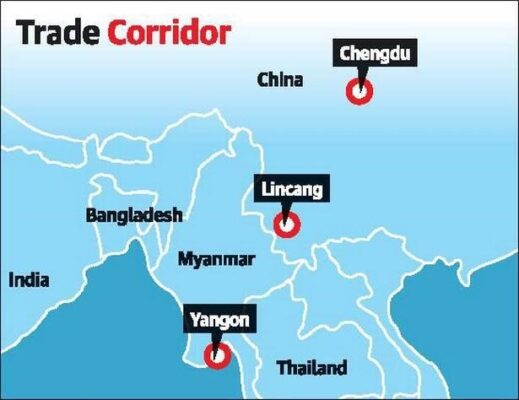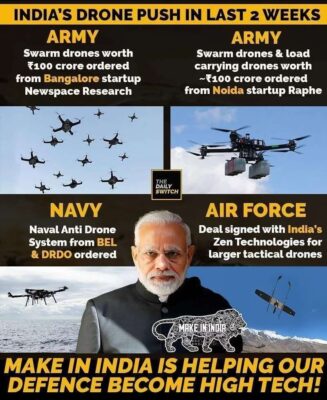- Home
- Prelims
- Mains
- Current Affairs
- Study Materials
- Test Series
02nd Sep 2021
IMPLEMENTATION OF NATIONAL TRUST ACT, 1999 IN JAMMU & KASHMIR AND LADAKH
Recently, the Ministry of Social Justice & Empowerment had organized a meeting with Govt. Officials, NGOs, parents and professionals from UTs of Jammu & Kashmir and Ladakh for implementation of National Trust Act, 1999 in the Union Territories.
National Trust?




 The Belt and Road Initiative, reminiscent of the Silk Road, is a massive infrastructure project that would stretch from East Asia to Europe. It was launched in 2013.
The plan is two-pronged: the overland Silk Road Economic Belt and the Maritime Silk Road-The two were collectively referred to first as the One Belt, One Road initiative but eventually became the Belt and Road Initiative.
The project involves creating a vast network of railways, energy pipelines, highways, and streamlined border crossings.
Pakistan and BRI:
To date, more than sixty countries—accounting for two-thirds of the world’s population—have signed on to projects or indicated an interest in doing so.
Analysts estimate the largest so far to be the estimated $60 billion China-Pakistan Economic Corridor, a collection of projects connecting China to Pakistan’s Gwadar Port on the Arabian Sea.
What was the original Silk Road?
The original Silk Road arose during the westward expansion of China’s Han Dynasty (206 BCE–220 CE), which forged trade networks throughout the Central Asian countries, as well as modern-day India and Pakistan to the south. Those routes extended more than four thousand miles to Europe.
How have other countries responded to BRI?
The Belt and Road Initiative, reminiscent of the Silk Road, is a massive infrastructure project that would stretch from East Asia to Europe. It was launched in 2013.
The plan is two-pronged: the overland Silk Road Economic Belt and the Maritime Silk Road-The two were collectively referred to first as the One Belt, One Road initiative but eventually became the Belt and Road Initiative.
The project involves creating a vast network of railways, energy pipelines, highways, and streamlined border crossings.
Pakistan and BRI:
To date, more than sixty countries—accounting for two-thirds of the world’s population—have signed on to projects or indicated an interest in doing so.
Analysts estimate the largest so far to be the estimated $60 billion China-Pakistan Economic Corridor, a collection of projects connecting China to Pakistan’s Gwadar Port on the Arabian Sea.
What was the original Silk Road?
The original Silk Road arose during the westward expansion of China’s Han Dynasty (206 BCE–220 CE), which forged trade networks throughout the Central Asian countries, as well as modern-day India and Pakistan to the south. Those routes extended more than four thousand miles to Europe.
How have other countries responded to BRI?



- The National Trust is a statutory body of the Ministry of Social Justice and Empowerment.
- It is set up under the “National Trust for the Welfare of Persons with Autism, Cerebral Palsy, Mental Retardation and Multiple Disabilities” Act 1999.
- It works towards providing opportunities for capacity development of Persons with Disability and their families, fulfilling their rights, facilitating and promoting the creation of an enabling environment and an inclusive society.
- Its aim is to create an enabling environment, i.e. providing opportunities for Persons with Disabilities through comprehensive support systems.
- The National Trust works for the welfare of persons with any of the following four disabilities:
- Autism
- Cerebral Palsy
- Mental Retardation
- Multiple Disabilities
- The objectives of the National Trust in particular are:
- to enable and empower persons with disability to live as independently and as fully as possible within and as close to the community to which they belong;
- to strengthen facilities to provide support to persons with disability to live within their own families;
- to extend support to registered organisations to provide need based services during period of crisis in the family of persons with disability;
- to deal with problems of persons with disability who do not have family support;
- to promote measures for the care and protection of persons with disability in the event of death of their parents or guardians;
- to evolve procedure for the appointment of guardians and trustees for persons with disability requiring such protection; and
- to facilitate the realisation of equal opportunities, protection of rights and full participation of persons with disability
- A Chairperson to be appointed by the Central Government from amongst the persons having expertise and experience in the field of autism, cerebral palsy, mental retardation and multiple disability;
- Nine persons to be appointed in accordance with such procedure as may be prescribed from amongst the registered organisations out of which three members each shall be from voluntary organisations, associations of parents of persons with autism, cerebral palsy, mental retardation and multiple disability and from associations of persons with disability, members;
- Eight persons not below the rank of Joint Secretary to the Government of India nominated by the Government to represent the Ministries or Departments of Social Justice and Empowerment, Women and Child Development, Health and Family Welfare, Finance, Labour, Education, Urban Affairs and Employment and Rural Employment and Poverty Alleviation, Members, ex officio;
- Three Persons to be nominated by the Board representing the associations of trade, commerce and industry engaged in philanthropic activities, members;
- The Chief Executive Officer, who, shall be of the rank of Joint Secretary to the Government of India, Member-Secretary, ex officio.

- The release provides data for two variables i.e. one tracks the total demand in the economy and the other the total supply.
- The first is GDP, which is the total monetary value of final goods and services i.e. those that are bought by the final user and produced in a country in a given period of time.
- The other is Gross Value Added or GVA which looks at how much value was added (in money terms) in different productive sectors of the economy.
- It tracks the total output in the economy by looking at the total supply.
- The GDP is derived by taking the GVA data and adding the taxes on different products and then subtracting all the subsidies on products.
- GDP = (GVA) + (Taxes earned by the government) — (Subsidies provided by the government)
- If the government earned more from taxes than what it spent on subsidies, GDP will be higher than GVA.
- If, on the other hand, the government provided subsidies in excess of its tax revenues, the absolute level of GVA would be higher than the absolute level of GDP.

- The data showed that in Q1 of 2021-22, India’s GDP grew by 20.1% while the GVA grew by 18.8%.
- The total output (as measured by GDP) of the Indian economy in the first three months of the current financial year was 20.1% more than the total output created by the economy in the same months last year.
- It is important to remember that GDP and GVA had contracted by 24.4% and 22.4%, respectively, in Q1 of the last financial year.
- A V-shaped recovery requires the absolute GDP of an economy getting back to the level before the crisis.
- India’s total output in Q1, whether measured through GDP or GVA, is nowhere near what it was in Q1 of 2019-20.
- It implies that India has produced the same amount of goods and services in Q1 this year as it produced in Q1 four years ago.

- Private Final Consumption Expenditure (PFCE): In India’s context, the biggest engine is consumption (C) demand from private individuals which is demand typically accounts for 56% of all GDP.
- It is defined as the expenditure incurred by the resident households and non-profit institutions serving households (NPISH) on final consumption of goods and services, whether made within or outside the economic territory.
- The GDP data shows that the private demand, biggest engine of growth, in Q1 of the current year was down to almost exactly the level where it was in 2017-18.
- Gross Fixed Capital Formation (GFCF): The second-biggest engine is the investment (I) demand generated by private sector businesses which accounts for 32% of all GDP in India.
- It refers to the aggregate of gross additions to fixed assets (that is fixed capital formation) plus change in stocks during the counting period.
- Government Final Consumption Expenditure (GFCE): The third engine is the demand for goods and services generated by the government (G) which accounts for 11% of India’s GDP.
- It is an aggregate transaction amount on a country's national income accounts representing government expenditure on goods and services that are used for the direct satisfaction of individual needs.
- Net Exports: The fourth engine is the demand created by “Net Exports” (NX).
- It is arrived at by subtracting the demand Indians have for foreign goods (that is, India’s imports) from the demand that foreigners have for Indian goods and services (that is, India’s exports).
- The National Institute for Communicable Diseases in South Africa has named the new variant as C.1.2 variant.
- It was first detected in May and has now spread to “the majority of the provinces in South Africa and in seven other countries spanning Africa, Europe, Asia and Oceania”.
- It was first detected in the Mpumalanga and Gauteng provinces of South Africa in May 2021.
- In June 2021, it was also detected in the KwaZulu-Natal and Limpopo provinces of South Africa as well as in England and China.
- It has been detected in six South African provinces (including the Eastern Cape and Western Cape), the Democratic Republic of the Congo, Mauritius, New Zealand, Portugal and Switzerland.
- It has “mutated substantially” in comparison to C.1 variant, which was one of the dominant lineages during the spike in infections during the first wave in South Africa.
- It is the speed at which it has been mutating which sets the C.1.2 variant apart from other Covid-19 strains.
- The study found that C.1.2 is undergoing 41.8 mutations per year, which is approximately 1.7-fold faster than the current global rate and 1.8-fold faster than the initial estimate of SARS-CoV-2 evolution.
- The variant has drawn the attention of scientists because of the rapid rate at which it is changing and the mutations within its genome.
- The study states that the short period of increased evolution compared to the overall viral evolutionary rate was also associated with the emergence of the Alpha, Beta and Gamma variants.
- The study also found that there were consistent increases in the number of C.1.2 genomes in South Africa each month, rising from 0.2 per cent of the genomes sequenced in May to 1.6 per cent in June and then to 2 per cent in July.
- The study further states that the C.1.2 has accumulated a number of substitutions beyond what would be expected from the background SARS-CoV-2 evolutionary rate.
- Scientists have found that C.1.2 carries some of the mutations that were previously seen in the C.1 variant.
- But it has picked up additional mutations within the ORF1ab, spike, ORF3a, ORF9b, E, M and N proteins.
- The T478K mutation which was seen in some of the C.1.2 variants is also found in Delta.
- C.1.2 contains many mutations that have been identified in all four VOCs (Alpha, Beta, Delta and Gamma) and three VOIs (Kappa, Eta and Lambda).
- It also has key additional mutations like Y449H at its receptor-binding domain and N679K adjacent to its furin cleavage site.
- Variant of Interest (VOI): A variant with specific genetic markers that have been associated with changes to receptor binding, reduced neutralization by antibodies generated against previous infection or vaccination, reduced efficacy of treatments, potential diagnostic impact, or predicted increase in transmissibility or disease severity, according to US Centers for Disease Control and Prevention.
- Variant of Concern (VOC): A variant for which there is evidence of an increase in transmissibility, more severe disease (like increment in hospitalizations, death rate, etc), a significant reduction in neutralization by antibodies generated during previous infection or vaccination, reduced effectiveness of treatments or vaccines, or diagnostic detection failures.
- Variant of High Consequence (VOHC): A variant of high consequence has clear evidence that prevention measures or medical countermeasures (MCMs) have significantly reduced effectiveness relative to previously circulating variants.
- The goods were shipped:
- From Singapore to Yangon Port in Myanmar.
- Entered by road transport in Lincang, southwest China's Yunnan Province.
- Transported to Chengdu directly through railway.
- The passage connects logistics lines of Singapore, Myanmar and China.
- It is currently the most convenient land and sea channel linking Indian Ocean with southwest China.
- The transportation distance is greatly shortened, with one-way journey saving 20 to 22 days.
- It will be a new channel for China to enter Atlantic Ocean via Indian Ocean and to directly carry out international trade and logistics.
 The Belt and Road Initiative, reminiscent of the Silk Road, is a massive infrastructure project that would stretch from East Asia to Europe. It was launched in 2013.
The plan is two-pronged: the overland Silk Road Economic Belt and the Maritime Silk Road-The two were collectively referred to first as the One Belt, One Road initiative but eventually became the Belt and Road Initiative.
The project involves creating a vast network of railways, energy pipelines, highways, and streamlined border crossings.
Pakistan and BRI:
To date, more than sixty countries—accounting for two-thirds of the world’s population—have signed on to projects or indicated an interest in doing so.
Analysts estimate the largest so far to be the estimated $60 billion China-Pakistan Economic Corridor, a collection of projects connecting China to Pakistan’s Gwadar Port on the Arabian Sea.
What was the original Silk Road?
The original Silk Road arose during the westward expansion of China’s Han Dynasty (206 BCE–220 CE), which forged trade networks throughout the Central Asian countries, as well as modern-day India and Pakistan to the south. Those routes extended more than four thousand miles to Europe.
How have other countries responded to BRI?
The Belt and Road Initiative, reminiscent of the Silk Road, is a massive infrastructure project that would stretch from East Asia to Europe. It was launched in 2013.
The plan is two-pronged: the overland Silk Road Economic Belt and the Maritime Silk Road-The two were collectively referred to first as the One Belt, One Road initiative but eventually became the Belt and Road Initiative.
The project involves creating a vast network of railways, energy pipelines, highways, and streamlined border crossings.
Pakistan and BRI:
To date, more than sixty countries—accounting for two-thirds of the world’s population—have signed on to projects or indicated an interest in doing so.
Analysts estimate the largest so far to be the estimated $60 billion China-Pakistan Economic Corridor, a collection of projects connecting China to Pakistan’s Gwadar Port on the Arabian Sea.
What was the original Silk Road?
The original Silk Road arose during the westward expansion of China’s Han Dynasty (206 BCE–220 CE), which forged trade networks throughout the Central Asian countries, as well as modern-day India and Pakistan to the south. Those routes extended more than four thousand miles to Europe.
How have other countries responded to BRI?
- Some countries see the project as a disturbing expansion of Chinese power.
- The United States shares the concern of some in Asia that the BRI could be a Trojan horse for China-led regional development and military expansion.

- China has both geopolitical and economic motivations behind the initiative.
- The country has promoted a vision of a more assertive China, while slowing growth and rocky trade relations with the United States have pressured the country’s leadership to open new markets for its goods.
- Experts see the BRI as one of the main planks of a bolder Chinese statecraft under Xi, alongside the Made in China 2025economic development strategy.
- The BRI also serves as pushback against the much-touted “pivot to Asia,”as well as a way for China to develop new investment opportunities, cultivate export markets, and boost Chinese incomes and domestic consumption.
- India has tried to convince countries that the BRI is a plan to dominate Asia, warning of what some analysts have called a “String of Pearls” geo-economic strategy whereby China creates unsustainable debt burdens for its Indian Ocean neighbors in order to seize control of regional choke points.
- In particular, New Delhi has long been unsettled by China’s decades-long embrace of its traditional rival, Pakistan.
- Information from the International Union for Conservation of Nature (IUCN) Red List on threats to 23,271 species representing all terrestrial amphibians, birds and mammals was used.
- Amphibian species were most likely to suffer extinction among all life forms, followed by mammals and birds.
- Amphibians were most likely to get extirpated due to agriculture, hunting and trapping, logging, pollution, invasive species and climate change.
- Agriculture posed the greatest threat for amphibians, with the highest probability of impact in 44 per cent of the mapped area.
- For birds, hunting and trapping was the most prevalent threat, constituting 50 per cent of the mapped range.
- For mammals, it was 73 per cent of the mapped area.
- Areas threatened by logging, hunting and trapping, agriculture, invasive species and climate change had greater than 50 per cent risk for amphibian, mammals and bird species.
- The islands of Sumatra and Borneo and Madagascar exhibited high probabilities of impact across all threats and life forms.
- Europe was impacted by a combination of agriculture, invasive species and pollution, making it a region with high impact probabilities.
- The polar region, the east coast of Australia and South Africa showed the highest impact probabilities for climate change, especially with respect to birds.
- Agriculture and logging were pervasive in the tropics.
- Hunting and trapping was the most geographically widespread threat to mammals and birds.
- Six principal threats: logging (a) agriculture (b), hunting and trapping (c), pollution (d), invasive species and diseases (e), and climate change (f).
- Agriculture had the highest average impact probability, followed by hunting and trapping and then by logging.
- The probability of being impacted by pollution was low in most parts of the terrestrial world.
- The probability of a species being impacted by invasive species was on average low for amphibians, mammals and birds.
- But it was more in some areas for birds and amphibians.

- NADS is the first indigenously developed anti-drone system to be inducted into the Indian armed forces.
- Developed by: Defence Research and Development Organisation
- Manufactured by: Bharat Electronics Limited
- Has both hard-kill and soft kill capabilities and offers 360-degree coverage.
- Can instantly detect micro drones and uses a laser-based kill mechanism to terminate the targets.
- Uses Radar, electro-optical/infrared (EO/IR) sensors and radio frequency (RF) detectors to detect and jam the micro drones.









 Latest News
Latest News
 General Studies
General Studies